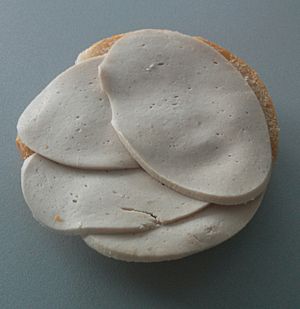Gelbwurst facts for kids
Gelbwurst is a special kind of sausage from Bavaria, Germany. Its name means "yellow sausage" in German. It's known for its light, yellowish-white color.
What is Gelbwurst?
Gelbwurst was first made in 1905. It is usually made from pork and veal. It also has a mix of tasty spices like ginger and nutmeg.
Long ago, some Gelbwurst recipes included brains. But this is not done anymore. Using brains in food was stopped in Germany in 2000 due to health concerns. Even so, some people in Germany still call it Hirnwurst, which means "brain sausage."
Gelbwurst looks yellowish-white. It often has a yellow or orange skin around its edge. People usually eat it cold, often on a slice of bread. It's best to eat it right away because it can spoil quickly.
How Gelbwurst is Made
The way Gelbwurst is made can be a little different depending on the recipe or where it comes from. In Germany, sausage makers often follow standard recipes.
To make Gelbwurst, they use pork and pork belly without the skin. These meats are slowly chopped up with ice until they become a smooth sausage mix. Common spices added are salt, pepper, mace, ginger, cardamom, and lemon powder.
The sausage mix is then put into special casings. These are usually yellow and artificial. They are about 50 to 60 mm wide and weigh about 1000 grams. After being cooked, the inside of the Gelbwurst should be a bright white color. Gelbwurst is different from other cooked sausages because it does not use special salt to make it red.
Special Types of Gelbwurst
Some types of Gelbwurst have extra ingredients. For example, the Hanoverian Brain Sausage and Hanoverian Bregenwurst have chopped onion mixed into the sausage. If natural casings are used, and they are up to 75 mm wide, the sausage is sometimes called white sausage.
In Bavaria, a region in Germany, people often mix finely chopped parsley into their yellow sausage. This makes the sausage look green and speckled.
According to German food rules, young beef can also be used to make yellow sausage. The rules also say that colored or yellow casings can be used for the sausage.


